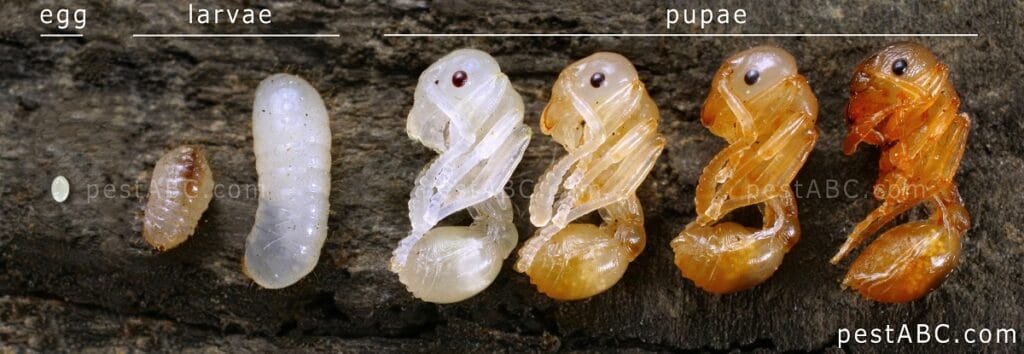Ants are absolutely fascinating creatures with many people being absolutely intrigued by the way their communities function. These small beasts seem to hone the power of something much stronger. Many people have also noticed that ants seem to be carrying something white, resembling a small white ball, and they’ve wondered what it was. So, what are those white things that ants are carrying?
These white eggs that ants carry are actually not eggs, but the pupal stage of complete metamorphosis. Ant eggs are almost microscopic, so you can’t really see them. It can also be larvae. If you’ve come across an ant pile and you see them carrying white eggs, it’s likely larvae or the pupal metamorphosis stage.
However, ants are so complex and the way they run their communities is so different from anything else in the world, there are many things about them that are certain to grab your attention and hold it. In this article, we’ll be taking a closer look at those small, egg-shaped white things and all the other things ants seem to carry.
Let’s get started!
What Are the White Things Ants Are Carrying?
If you’ve stumbled upon an ant pile and you want to know what it is that they’re carrying, it can actually be a lot of things.
Firstly, we’d like to advise that you leave their den alone, as you wouldn’t like some giant disturbing your home either. However, those small white things can actually be eggs, only not eggs that were just laid.
These eggs are already in an advanced stage of metamorphosis, eggs that were just laid are completely invisible to the human eye, as they’re microscopic.
However, this may not be the case, as it can also be larvae. It can also be food – ants are scavengers and they collect anything that they can consume – it’s not without reason that they invade every picnic they come upon. It can be any edible substance that’s white: bread, rice, etc.
Ever wondered How Ants Just Appear Out of Nowhere?
How to Distinguish Eggs, Larvae, and Pupae? (With Image)
Unlike humans, ants go through a completely different process before they’re ready to start serving their queen. They conduct a complex metamorphosis before they are considered full-grown and ready.
They usually go through three different phases before they’re fully grown. All ants are eggs at first (layed by the queen, which is her primary task). After that, they’ll form into larvae, and lastly, they’ll form into pupae.

EGGS are usually very small. They’re oval and resemble small balls, and they’re also sticky. This sticky matter is the glue that holds all the eggs together when they’re laid – this way, ants can carry eggs more easily. This is important in case the nest is invaded and the eggs need to be saved.
Not all eggs are fertile, though, as the queen can lay trophic eggs. They’re made for eating and are not going to turn into ants. She can even convert her wing muscles into eggs which she will eat to keep her strength.
LARVAE, on the other hand, is the next step in ant evolution. They’re also white, so people often mistake them for eggs, but they’re not resembling a ball – they’re longer. Larvae are transparent, long, and shaped like bananas. They are also sticky but aren’t covered with any sort of matter, rather with hairs.
These hairs stick one larva to another and they have the same function as the glue on eggs. Larvae have to be fed with protein often. They’re usually kept next to the eggs, so it’s been documented that larvae sometimes eat the eggs.
So, to differ the eggs and the larvae, we need to understand that they’re both white. However, eggs are oval, resembling tiny white balls, or even rice. Larvae, on the other hand, are longer. If you look closely enough (with a microscope), you’ll notice that they have hair on them. Another important difference is the fact that larvae are much larger than eggs.
PUPAE are evolved larvae and they look like adult ants. Pupae don’t grow, but the body parts are evolving. Ant pupae are usually naked but there are some species having cocoons as a protective shell. The color changes from white to the final hue of the adult ant.
| Eggs | Larvae | Pupae |
| white | white | (white) |
| oval (ball-shaped) | long (banana-shaped) | naked or cocon |
| very small | 10-30 x larger | ant-sized |
| plain | hair | ant look |
Other White Things Ants Can Carry
It’s often found that ants are carrying other species’ eggs, as well. There are no rules in the animal kingdom, and if they have the opportunity, ants will steal other insects’ eggs and carry them back to their nest to feast on them. For example, they might steal bee eggs.
You’ll also find that ants may steal honeycombs from bees, which are white when they’re just created (they become dark once they’ve stopped using them).
It was also documented that ants take building materials and carry them. What you think is food may actually be just a really small piece of leaf. It’s impossible to list all the things that ants may be carrying, but it could be literally anything that’s edible.
Ants are never going to refuse any sort of food that’s edible to them, and they’re always going to take it. It’s even possible that it’s a piece of animal skin they found on a carcass.

